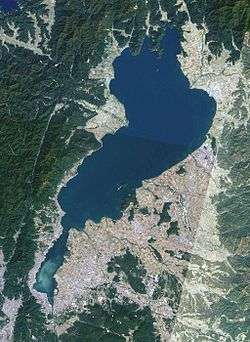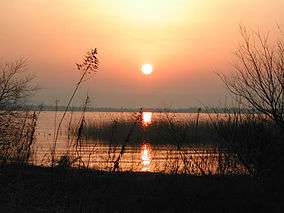Lake Biwa
| Lake Biwa | |
|---|---|
 from space | |
| Coordinates | 35°20′N 136°10′E / 35.333°N 136.167°ECoordinates: 35°20′N 136°10′E / 35.333°N 136.167°E |
| Primary inflows | 118 rivers |
| Primary outflows | Seta River |
| Catchment area | 3174 km² |
| Basin countries | Japan |
| Max. length | 63.49 km (39.5 miles) |
| Max. width | 22.8 km (14.2 miles) |
| Surface area | 670.4 km² (258.8 square miles) |
| Max. depth | 103.58 m (339.8 feet) |
| Water volume | 27.5 km³ |
| Residence time | 5.5 years |
| Shore length1 | 235.2 km (146.1 miles) |
| Surface elevation | 85.6 m (280.8 feet) |
| Islands | 3 |
| Settlements | Hikone, Otsu, Nagahama, Takashima |
| Designated | 10 June 1993 |
| 1 Shore length is not a well-defined measure. | |

Lake Biwa (Japanese: 琵琶湖 Hepburn: Biwa-ko) is the largest freshwater lake in Japan, located in Shiga Prefecture (west-central Honshu), northeast of the former capital city of Kyoto.[1] Because of its proximity to the ancient capital, references to Lake Biwa appear frequently in Japanese literature, particularly in poetry and in historical accounts of battles.
Name
The name Biwako was established in the Edo period. There are various theories about the origin of the name Biwako, but it is generally believed to be so named because of the resemblance of its shape to that of a stringed instrument called the biwa. Kōsō, a learned monk of Enryaku-ji in the 14th century, gave a clue to the origin of the name Biwako in his writing: "The lake is the Pure land of the goddess Benzaiten because she lives on Chikubu Island and the shape of the lake is similar to that of the biwa, her favorite instrument."[2]
The lake was formerly known as the Awaumi (淡海?, Freshwater Sea) or the Chikatsu Awaumi (近淡海?, Freshwater Sea Near the Capital) . Later the pronunciation Awaumi changed to the modern Ōmi as in the name of Ōmi Province. The lake is also called Nio no Umi (鳰の海?, "Little Grebe Lake") in literature.
Area and use
The area of this lake is about 670 km². Small rivers drain from the surrounding mountains into Lake Biwa, and its main outlet is the Seta River, which later becomes the Uji River, combining with the Katsura and Kizu to become the Yodo River and flows into the Seto Inland Sea at Osaka Bay.
It serves as a reservoir for the cities of Kyoto and Ōtsu and is a valuable resource for nearby textile industries. It provides drinking water for about 15 million people in the Kansai region. Lake Biwa is a breeding ground for freshwater fish, including trout, and for the pearl culture industry.
The Lake Biwa Canal, built in the late 1890s and later expanded during the Taishō period played a role of great importance in the rekindling of Kyoto's industrial life, after a steep decline following the transfer of the capital to Tokyo.
Lake Biwa is home to many popular beaches along the north-western shore, in particular, for example, Shiga Beach and Omi-Maiko. The Mizunomori Water Botanical Garden and The Lake Biwa Museum in Kusatsu are also of interest.
The Lake Biwa Marathon takes place in Otsu, the city at the southern end of the lake annually since 1962.
Natural history
Lake Biwa is of tectonic origin and is one of the world's twenty oldest lakes, dating to almost 4 million years ago. This long uninterrupted age has allowed for a notably diverse ecosystem to evolve in the lake. Naturalists have documented about 1100 species in the lake, including 58 endemic species. Lake Biwa is an important place for water birds. About 5,000 water birds visit Lake Biwa every year.
There are 46 native fish species and subspecies in the lake, including 12 endemic species and 5 endemic subspecies.[3] The endemic species are five cyprinids (Biwia yodoensis, Carassius cuvieri, Gnathopogon caerulescens, Ischikauia steenackeri and Sarcocheilichthys biwaensis), two true loaches (both undescribed species of Cobitis), two gobies (Gymnogobius isaza and an undescribed species of Rhinogobius), two silurid catfish (Silurus biwaensis and S. lithophilus) and a cottid (Cottus reinii).[3] The Biwa trout is also endemic to the lake, but some maintain that it is a subspecies of the widespread masu salmon rather than a separate species.[3] The remaining endemic fish are subspecies of Carassius auratus, Plecoglossus altivelis, Sarcocheilichthys variegatus and Squalidus chankaensis.[3]
Lake Biwa is also the home of a large number of molluscs, including 38 freshwater snails (19 endemic) and 16 bivalves (9 endemic).[4]
Recently the biodiversity of the lake has suffered greatly due to the invasion of foreign fish, the black bass and the bluegill. Bluegill were presented to the Emperor and later freed in the lake as a food source for other fish. Black bass were introduced as a sport fish. In July 2009, a largemouth bass weighing 22 pounds, 4 ounces (about 10.09 kg) was caught in the lake by Manabu Kurita. It has been officially certified by the International Game Fish Association (IGFA) to tie the largemouth bass world record held solely by George Perry for 77 years.
Archaeology
The Awazu site, a submerged shell-midden of Lake Biwa, is an important archaeological site of Jomon period. It goes back to the beginning of the Initial Jomon period (ca. 9300 BP). It lies near the southern end of Lake Biwa, close to Otsu City, at a depth of 2 to 3m from the bottom.[5]
The site shows the use of plant and animal food resources by Jomon peoples. It also demonstrates the importance of nut consumption in this period.
Shell Midden No. 3 is dated to the Middle Jomon period. An abundance of horse chestnuts was uncovered here (c. 40% of the total estimated diet). This indicates that, by this later period, a sophisticated processing technology was mastered in order to remove the harmful tannic acid, and make this food safe for consumption.[6]
Ishiyama is another such site of early Jomon period on Lake Biwa.[5]
Environmental legislation
Various environmental laws cover Lake Biwa:
Eutrophication prevention
Legislation to prevent eutrophication was enacted in 1981 and first enforced on July 1, 1982; therefore, this day is called "Lake Biwa Day (びわ湖の日 Biwako no Hi)". The legislation established standards for the nitrogen and phosphorus levels for agricultural, industrial, and household water sources emptying into the lake. They also banned people from using and selling synthetic detergents which contain phosphorus.
Wetlands protection
The lake was designated as a UNESCO Ramsar Wetland (1993) in accordance with the Ramsar Convention. The object of this treaty is to protect and sensibly use internationally valuable wetlands. The Kushiro marsh (釧路湿原, Kushiro Shitsugen) in Japan is under this treaty now.
Conservation of Reed Vegetation Zones
Reed colonies on the shore form give Lake Biwa its characteristic scenery. The reeds play an important role in purifying water as well as providing habitat for birds and fish. At one time there were large areas of reeds along the shores of Lake Biwa, which local government surveys recently found to have halved in size due to encroaching development. This Shiga Ordinance for the Conservation of Reed Vegetation Zones to protect, grow, and utilize the reed beds has been in force since 1992.
Gallery
 Lake Biwa at Chomeiji-cho, Ōmihachiman
Lake Biwa at Chomeiji-cho, Ōmihachiman- Lake Biwa Canal
 Mangetsu-ji temple, one of the Eight Views of Omi
Mangetsu-ji temple, one of the Eight Views of Omi a pleasure boat from the Otsu port
a pleasure boat from the Otsu port
See also
- Eight Views of Omi
- Biwako Line
- Biwako Quasi-National Park
- Birdman Rally (1977–), the yearly televised homemade glider and human-powered flight competition.
- Biwa town, a town on the northern shore of Lake Biwa and its name was named after Lake Biwa.
- F.C. Mi-O Biwako Kusatsu, a football club based in Kusatsu, Shiga, facing the lake.
- Tourism in Japan
- Lake Hamana, a lake in Shizuoka Prefecture, its old name was "distant fresh-water sea".
References
- ↑ "Biwa, Lake". Academic Dictionaries and Encyclopedias.
- ↑ Yoshihiro Kimura (2001). Biwako -sono koshō no yurai- [Lake Biwa, the origin of its name]. Hikone: Sunrise Publishing. ISBN 4-88325-129-2
- 1 2 3 4 Kawanabe, H.; Nishino, M.; and Maehata, M., editors (2012). Lake Biwa: Interactions between Nature and People. pp 119-120. ISBN 978-94-007-1783-1
- ↑ Segers, H.; and Martens, K; editors (2005). The Diversity of Aquatic Ecosystems. p. 46. Developments in Hydrobiology. Aquatic Biodiversity. ISBN 1-4020-3745-7
- 1 2 Francesco Menotti, Aidan O'Sullivan, The Oxford Handbook of Wetland Archaeology. OUP Oxford, 2013. ISBN 0199573492 p.181
- ↑ Habu, Junko; Matsui, Akira; Yamamoto, Naoto; Kanno, Tomonori (2011). "Shell midden archaeology in Japan: Aquatic food acquisition and long-term change in the Jomon culture" (PDF). Quaternary International. 239 (1-2): 19–27. doi:10.1016/j.quaint.2011.03.014. ISSN 1040-6182.
External links
| Wikimedia Commons has media related to Lake Biwa. |
| Wikivoyage has a travel guide for Lake Biwa. |
| Wikisource has the text of the 1905 New International Encyclopedia article Biwa. |
- Department of Lake Biwa and Environment, Shiga Prefecture
- Lake Biwa Environmental Research Institute
- Ramsar site database
- go.biwako - Travel Guide of Shiga Prefecture, Japan
- Lake Biwa (World Wildlife Fund)
- Review of Criodrilidae (Annelida: Oligochaeta) including Biwadrilus from Japan
- Live Webcam of Biwako
- Japan's Secret Garden NOVA / PBS
- Fishing World Records